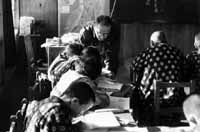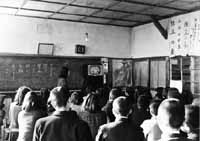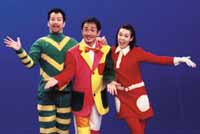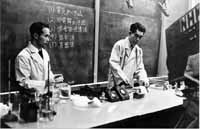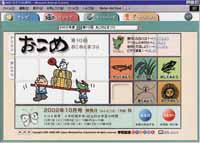|
TV goes to school
When television broadcasting first started
in Japan, 15 minutes per day was devoted to schools broadcasts for classroom
viewing. A science program, Liquid Air,
was a special landmark. It enabled students to watch experiments that
would be hard to carry out in the classroom, and demonstrated the enormous
potential of television as an educational medium.
NHK's Educational TV channel was launched
in January 1959. From April of that year, 35 schools programs were broadcast
per week, accounting for two hours and 15 minutes of programming per
day. Science Class led the way, offering
grade-specific programming for students between the ages of about 10
and 15. Junior high school English and elementary school social studies
soon followed on the same model. Schools all over Japan swiftly adopted
this televised curriculum after the release of 17-inch screen TV sets
with front-mounted speakers and lockable folding doors.
Learning for everyone
In April 1963, NHK began regular broadcasts
of high school correspondence course programming targeted at working
youth, housewives and the elderly. Classes delivered by TV became an
important means of learning for students studying for their high school
diploma while also holding a job. NHK Gakuen, Japan's first correspondence
high school for people living anywhere in the nation, also opened that
year. In the 40 years since then, more than 50,000 people have earned
their high school diploma through NHK Gakuen's correspondence courses.
|
|
In the vanguard
By around the mid-1970's, more than 95%
of Japan's elementary and 50% of its junior and senior high schools
were tuning in to schools broadcasts. In response to a controversy about
curricular diversity, then being discussed by the National Diet's Education
Council, NHK began to explore different content for schools broadcasts.
Newly created programs addressed environmental and life-study themes
that transcended conventional subject boundaries. In terms of their
aim, these programs were a precursor of today's "Period for Integrated
Study" at schools, which is itself driving the development of various
new schools programs.
Digital educational contents
As the 80's turned into the 90's, research
on the use of computers in education blossomed. In 1998, NHK launched
the environmental education program Internet
School: Only One Earth, making use of the Internet for interactive
learning. According to plans laid out by the Ministry of Education,
Culture, Sports, Science and Technology (MEXT), by the end of 2005 every
classroom in every one of Japan's 40,000-plus public schools will have
broadband Internet access. Nowadays, classes draw frequently on the
information resources of the Internet. So from 2001, NHK began providing
digital learning materials on its website, including programs and short
video clips. NHK's digital learning material has won plaudits around
the world. The program Eigorian, which
helps third- and fourth-grade elementary school pupils learn English,
was awarded the Prix Italia in September 2002.
|
Rewarding the best:
The Japan Prize
The Japan Prize, the world's first international educational program
contest, was established by NHK in 1965. It was greeted with excitement
by people involved in educational broadcasting all over the world.
The Japan Prize was awarded for the 30th time in 2003. It has
reflected the development of educational broadcasting worldwide,
holding up a mirror to each changing era and deepening international
understanding. In 2002, acknowledging the worldwide effort to
improve the use of the Internet with educational programs, the
Japan Prize also established a new Web Division. Each year, the
Japan Prize attracts more than 200 entries from 49 nations.
|
|

